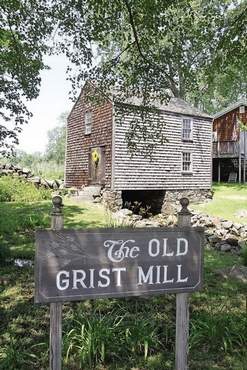Voters to Decide on $34K Warrant Article
By Patrick Cronin
Hampton Union, Tuesday, March 6, 2012
[The following article is courtesy of the Hampton Union and Seacoast Online.]

for structural repairs to the Deacon Tuck Gristmill.
[Courtesy photo]
HAMPTON — The Deacon Tuck Gristmill Committee is working behind the scenes to restore a Hampton landmark to its former glory so that people of all ages can enjoy the old mill that sits on High Street near Mill Pond for years to comes.
Committee member Candice Stellmach said a big part of reaching that goal is getting voters to support their $34,260 petition warrant article at the March 13 election to make much needed structural repairs to the 326- year-old mill.
The money would pay to repair the stone foundation, the roof, siding and flooring of the mill.
With approval of Hampton voters, not only will the artifacts of colonials be saved, but the building finally will be restored and allow visitors inside,” Stellmach said.
The town purchased the historic mill for $5,000 in 1960.
The mill was built by Deacon John Tuck on Sept. 16, 1686, and was used for 200 years to grind Indian corn into fresh flour and meal, one of the main food staples during the Colonial era.
Of 21 mills in Hampton, the Old Grist Mill is the only one that remains.
Stellmach said the repairs would ensure the structure remains intact for the next 30 years and will allow them to apply for more grants to restore the interior of the mill.
But the goal, she said, is not to get the mill operational again, but rather for it to serve as a museum.
“We don’t want to grind corn, but we do want to enable visitors, especially students, to see and understand the mechanics those colonists designed to survive in the new world,” Stellmach said.
Master Carpenter Dave DeGagne is currently working on making a miniature model of the mill to aid in the restoration project. He created a similar type model for the Hampton Historical Society’s barn in order to plan every step of its reconstruction at the Tuck Museum.
Stellmach said the committee conducted a lot of research on the history of the mill, as well as looking at architectural drawings of other area mills. “It was important to understand the most probable layout of the machinery in the original mill,” Stellmach said.
The committee believes the original power source of the mill was a tub wheel, similar to the early wheel used in the Winnicut Mill, which remains only on paper and in photos now.
But before they can recreate the mechanics of the mill interior, Stellmach said they need to repair the structure itself.
“What will it cost?” Stellmach said. “Only the cost of a gourmet cup of coffee for a household.”
Stellmach said their ultimate goal once repairs are made is to put the mill on New Hampshire’s Registry of Historic Buildings and for it to be an educational resource.
“It’s a fantastic place for kids to learn,” Stellmach said. “We want to get people inside that building.” Stellmach, whose family once owned the mill, said it’s important to preserve the important piece of history. “We are so lucky to have one of the few old mills in the state,” Stellmach said.
The petition warrant article has already received the backing of selectmen, the Budget Committee and the Hampton Historical Society.

Voters will be asked to spend about $34,000 on repairs to the 326-year-old structure.
[Courtesy photo]